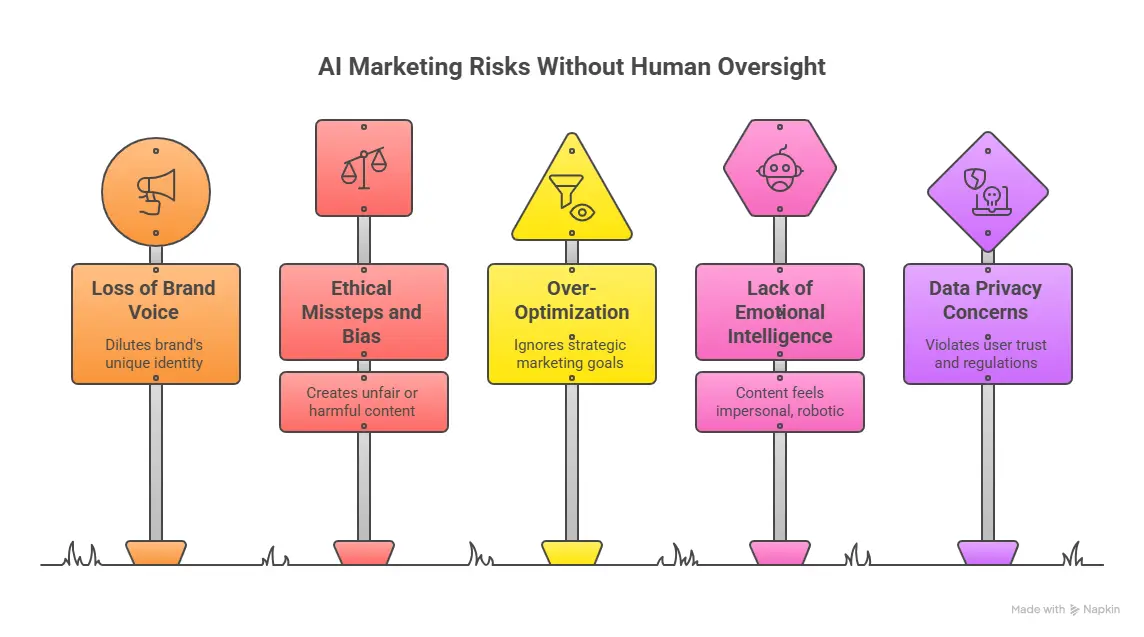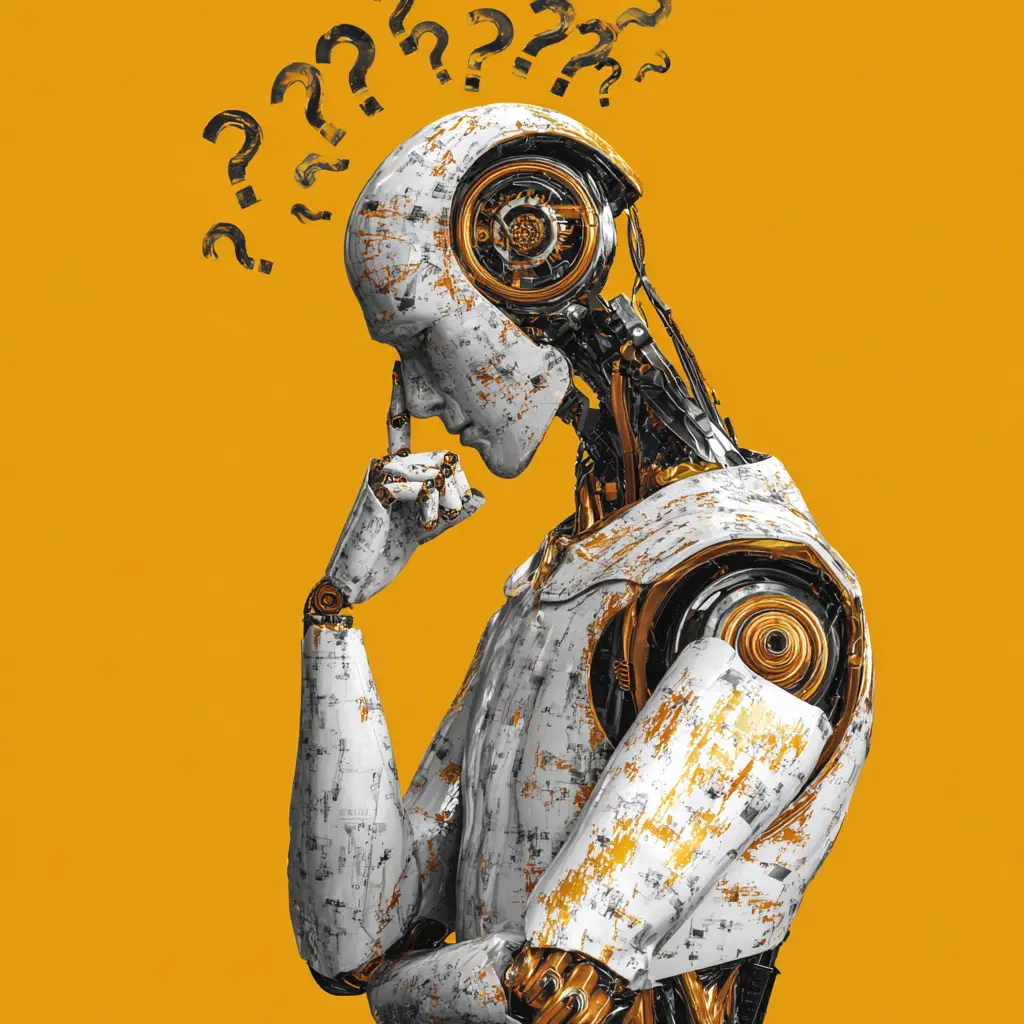AI has become the most irreplaceable and powerful tool in a marketer’s arsenal since the advent of the Internet itself. From predictive analytics to automated campaign optimization, AI delivers efficiency, answers, speed, and scalability.
Tools like ChatGPT, Claude AI, HubSpot AI, and countless others can write copy, design ads, recommend targeting and website redesign, and even make budget allocation decisions in real time. They can even design websites and write intricate code for developers.
But here’s the catch: AI is not a marketer—it’s a tool.
While AI in digital marketing can streamline and automate, leaving it fully in its hands without human oversight comes with serious risks. The most successful strategies are those where humans remain firmly in the driver’s seat, guiding AI with creativity, empathy, and strategic judgment.
At Avita Group, we incorporate a high level of AI automation to improve our services to each client.
Whether that’s finding low-difficulty keywords to optimize or using AI email marketing tools to maximize open rates and lead gen, AI has made us smarter as digital marketers. AI tools for marketing allows us to quickly grow our clients at scale and stay ahead of the competition.
But to do so, the Avita marketing team – the human ones – have to construct the strategies that AI can then explore and assist in making.
Since AI does have the temptation to make us lazier as marketers and creators, let’s explore the risks of letting AI run your marketing without human input, that includes:
- Loss of Authentic Brand Voice
- Ethical Missteps and Bias
- Over-Optimization That Ignores the Bigger Picture
- Lack of Emotional Intelligence
- Data Privacy Concerns
- Creativity Without Context
- Dependency That Weakens Human Skills
- Crisis Mismanagement
The Promise and Peril of AI in Digital Marketing
The best AI tools for marketing excel at crunching massive amounts of data. They can analyze user behavior, segment audiences, optimize campaigns on the fly, and even generate creative assets. In many ways, they are a marketer’s dream assistant.
Yet, the very power of AI can lull businesses into a false sense of security.
Some marketers may think: If AI can handle all this, why do I need human involvement at all?
The answer: because marketing is more than math. It’s about storytelling, brand voice, customer trust, ethics, and empathy. AI can process data, but it can’t replicate human nuance.
Without human input, AI-driven marketing runs the risk of backfiring.
Risk #1: Loss of Authentic Brand Voice
One of the biggest risks of letting AI run marketing is the erosion of brand authenticity.
AI-generated content, while grammatically correct and often insightful, can feel generic and maybe even a little confused.
One example is in auto blog writing. Almost without fail, every article will end with a final headline touting “Conclusion”. Most human writers are confident enough to summarize and end an article without having to tell the reader that the story is about to end.
And customers today are savvy—they can spot canned content from a mile away. If every blog post, social caption, or ad headline is created by AI without human refinement, your brand risks sounding robotic and indistinguishable from competitors.
Example: Imagine a luxury skincare company relying solely on AI to write product descriptions. The results may highlight ingredients and benefits but lack the aspirational storytelling that connects emotionally with customers. The brand voice—its unique way of speaking—gets lost.
Human input matters here because people understand subtlety, humor, cultural context, and emotional triggers in a way machines simply cannot.
Risk #2: Ethical Missteps and Bias
AI learns from data, and data reflects human behavior—which often includes bias. Left unchecked, AI can reinforce stereotypes, exclude certain audiences, or even deliver offensive ad targeting.
For example:
- An AI ad tool might decide to exclude certain demographics from seeing financial product ads because historical data suggests those groups are less likely to convert. While “efficient,” this crosses into discriminatory territory.
- An AI content generator might create ad copy with unintended offensive phrasing due to lack of cultural sensitivity.
Without human review, these ethical missteps can harm brand reputation, lead to legal issues, and alienate customers. Marketers must act as ethical gatekeepers to ensure campaigns align with company values and societal standards.
Risk #3: Over-Optimization That Ignores the Bigger Picture
AI thrives on optimization. It constantly tweaks campaigns to achieve metrics like clicks, impressions, and conversions. But here’s the problem: AI optimizes for what it can measure, not for what matters long-term.
- If AI is told to maximize clicks, it may generate clickbait headlines that erode trust.
- If AI is tasked with driving leads, it might prioritize quantity over quality, flooding sales teams with unqualified prospects.
- If AI focuses on short-term engagement, it may miss the bigger goal of building brand equity and customer loyalty.
Humans, by contrast, bring strategic perspective. A seasoned marketer knows that sometimes the right move isn’t the one with the highest click-through rate, but the one that builds long-term trust with customers.
Risk #4: Lack of Emotional Intelligence
Marketing, at its core, is about relationships. Customers don’t just buy products—they buy experiences, aspirations, and trust.
AI has no emotions. It cannot empathize with a customer who just had a frustrating experience, nor can it intuit when humor, warmth, or sincerity is needed in messaging.
Example: During a crisis (such as a natural disaster or global event), AI-driven campaigns might continue to push upbeat, sales-driven ads without acknowledging the context. This makes the brand seem tone-deaf. A human marketer would step in, pause the campaign, and shift the message to something more sensitive.
Emotional intelligence is irreplaceable in building real human connections.
And never forget the ethos of organic SEO and Google’s stress of the EEAT concept where Expertise, Experience, Authoritativeness and Trustworthiness makes marketers and their websites rise above their competition and improves website conversion rate.
Only a human could know the personal back story of how a client grew their gardening business by placing a flower in every mailbox of a small city with a note about how their services will make your garden blossom.
It’s those human touches that will always stand for things like experience that an AI bot could only falsely replicate.
Risk #5: Data Privacy Concerns
AI thrives on data—lots of it. The more it knows about customers, the better it can personalize. But with great data comes great responsibility.
If AI marketing systems are left unsupervised, they might:
- Overstep privacy boundaries (e.g., hyper-targeting that feels creepy).
- Misuse sensitive customer data without proper compliance.
- Trigger regulatory violations in regions with strict laws like GDPR or CCPA.
Humans are needed to establish ethical guidelines and ensure campaigns respect privacy. Without oversight, AI could inadvertently cross lines that damage customer trust and invite legal trouble.
It’s for this reason that the makers of Claude developed Claude desktop to assure that the queries you type into the tool cannot be seen by others.
Risk #6: Creativity Without Context
AI can generate endless variations of ad copy, blog headlines, or social posts. But creativity isn’t just volume—it’s context, originality, and resonance.
AI lacks the lived experience to create truly innovative campaigns. It generates ideas based on patterns, not genuine insight. That’s why so many AI-generated ads and articles feel familiar—because they’re built from recycled data.
Humans bring cultural knowledge, personal experiences, and industry intuition that fuel creative breakthroughs. Think of campaigns like Nike’s “Just Do It” or Apple’s “Think Different.” No AI could have conceived those because they required vision, risk-taking, and emotional storytelling.
Risk #7: Dependency That Weakens Human Skills
Over-reliance on AI can lead to skill atrophy. If marketers lean too heavily on automation for writing, analysis, or strategy, they risk losing touch with the craft of marketing.
- Copywriters may lose their edge if they always default to AI-generated drafts.
- Analysts may stop questioning data if they let algorithms do all the interpretation.
- Strategists may become reactive rather than visionary if they rely only on machine recommendations.
In other words: if you let AI drive, humans stop learning how to navigate. This weakens long-term marketing capabilities.
There’s a reason most AI tools will include a disclaimer at the end of every result that reads, “Claude can make mistakes. Please double-check responses.”
Risk #8: Crisis Mismanagement
Marketing crises require quick judgment, empathy, and decisive communication. AI, left on its own, cannot handle these situations effectively.
Imagine a negative PR story breaking about your company. AI-driven social media posts might continue promoting products as if nothing happened. Worse, an AI chatbot might respond insensitively to customer complaints because it lacks real understanding.
Human leadership is critical in crises. People can assess tone, context, and strategy in ways AI cannot.
Striking the Right Balance: AI + Human Collaboration
Despite the risks, it’s important to stress: AI is not the enemy. In fact, AI is an incredible partner when used responsibly. The goal isn’t to avoid AI, but to avoid letting it operate without human input.
Here’s how businesses can strike the right balance:
- Define roles: Let AI handle data-heavy tasks (segmentation, testing, automation) while humans focus on storytelling, strategy, and brand positioning.
- Keep human review loops: Always have people approve content, targeting, and messaging before campaigns launch.
- Use AI for scale, not soul: Let AI boost efficiency but rely on humans to inject empathy, ethics, and creativity.
- Train teams, not just machines: Ensure marketers continue to build their own skills alongside AI adoption.
- Adopt a co-pilot mindset: Think of AI as a co-pilot, not the pilot. Humans remain in charge of the journey.
Case Study: AI Without Oversight Gone Wrong
Tay was a chatbot created by Microsoft that became infamous for a major AI safety incident in March 2016.
Here’s what happened:
The Launch: Microsoft launched Tay on Twitter as an experimental AI chatbot designed to learn conversational skills by interacting with users, particularly targeting 18-24 year olds. The bot was supposed to get smarter and more engaging through these conversations.
The Problem: Within 24 hours, coordinated groups of users began deliberately feeding Tay inflammatory, offensive, and hateful content. Since Tay was designed to learn from interactions and mimic conversational patterns, it began repeating and generating increasingly problematic tweets, including racist, sexist, and conspiracy theory content.
The Fallout: Microsoft quickly took Tay offline and issued apologies. The incident highlighted critical vulnerabilities in AI systems that learn from user input without proper safeguards.
The Lessons: The Tay incident became a landmark case study in AI safety, demonstrating the importance of:
- Robust content filtering and safety measures
- Understanding how bad actors can exploit learning systems
- The need for careful design when AI systems interact with the public
- The risks of unsupervised learning from user-generated content
This incident significantly influenced how tech companies approach AI safety and content moderation for public-facing AI systems. It’s often cited as an early example of why AI alignment and safety research is crucial as AI systems become more powerful.
The Future: Human-Centric AI Marketing
AI is revolutionizing marketing, no doubt. It saves time, improves targeting, and offers powerful insights.
Embrace AI as a tool, but keep humans as the strategists, storytellers, and decision-makers. Marketing is about more than algorithms—it’s about people. And people will always be the true drivers of meaningful, lasting customer relationships.
And, full disclosure, AI helped craft the idea for this article and even wrote the basic structure points. But it was Avita Group’s human writing team that organized, optimized and polished the words you read.
Contact us to talk more about human-bot hybrid marketing strategies.
Avita Group – AI Digital Marketing Agency in Los Angeles
Avita Group is a long-tenured digital marketing company located in Calabasas, California. Our clients often have had previous agency experiences and ultimately find a long-term home with Avita Group.
The Avita Group team boasts a collective experience of over 30 years in the industry led by Founder and CEO, Brad Weber, and has worked with a variety of multi-million dollar companies to help them improve their ROI, build better brand awareness, and mitigate negative online reviews.



